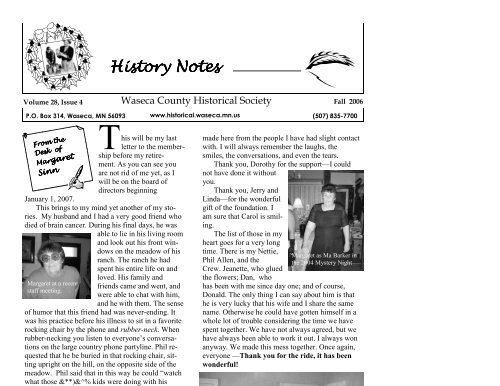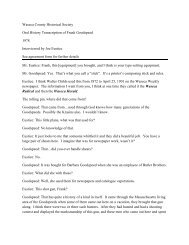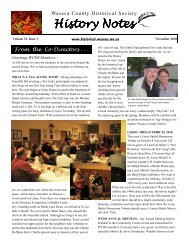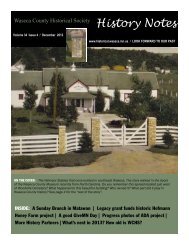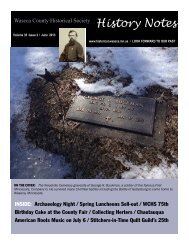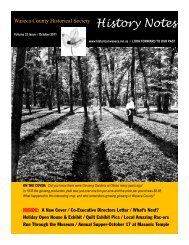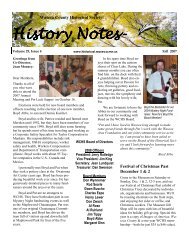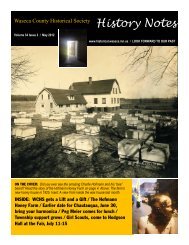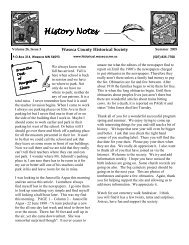Fall - Waseca County Historical Society
Fall - Waseca County Historical Society
Fall - Waseca County Historical Society
Create successful ePaper yourself
Turn your PDF publications into a flip-book with our unique Google optimized e-Paper software.
History Notes<br />
Volume 28, Issue 4<br />
<strong>Waseca</strong> <strong>County</strong> <strong>Historical</strong> <strong>Society</strong><br />
<strong>Fall</strong> 2006<br />
P.O. Box 314, <strong>Waseca</strong>, MN 56093<br />
From the<br />
Desk of<br />
Margaret<br />
Sinn<br />
Mar<br />
T<br />
his will be my last<br />
letter to the membership<br />
before my retirement.<br />
As you can see you<br />
are not rid of me yet, as I<br />
will be on the board of<br />
directors beginning<br />
January 1, 2007.<br />
This brings to my mind yet another of my stories.<br />
My husband and I had a very good friend who<br />
died of brain cancer. During his final days, he was<br />
able to lie in his living room<br />
and look out his front windows<br />
on the meadow of his<br />
ranch. The ranch he had<br />
spent his entire life on and<br />
Margaret at a recent<br />
staff meeting.<br />
loved. His family and<br />
friends came and went, and<br />
were able to chat with him,<br />
and he with them. The sense<br />
of humor that this friend had was never-ending. It<br />
was his practice before his illness to sit in a favorite<br />
rocking chair by the phone and rubber-neck. When<br />
rubber-necking you listen to everyone’s conversations<br />
on the large country phone partyline. Phil requested<br />
that he be buried in that rocking chair, sitting<br />
upright on the hill, on the opposite side of the<br />
meadow. Phil said that in this way he could “watch<br />
what those &**)&^% kids were doing with his<br />
www.historical.waseca.mn.us<br />
(507) 835-7700<br />
made here from the people I have had slight contact<br />
with. I will always remember the laughs, the<br />
smiles, the conversations, and even the tears.<br />
Thank you, Dorothy for the support—I could<br />
not have done it without<br />
you.<br />
Thank you, Jerry and<br />
Linda—for the wonderful<br />
gift of the foundation. I<br />
am sure that Carol is smiling.<br />
The list of those in my<br />
heart goes for a very long<br />
time. There is my Nettie,<br />
Phil Allen, and the<br />
Crew. Jeanette, who glued<br />
the flowers; Dan, who<br />
has been with me since day one; and of course,<br />
Margaret as Ma Barker in<br />
the 2004 Mystery Night<br />
Donald. The only thing I can say about him is that<br />
he is very lucky that his wife and I share the same<br />
name. Otherwise he could have gotten himself in a<br />
whole lot of trouble considering the time we have<br />
spent together. We have not always agreed, but we<br />
have always been able to work it out. I always won<br />
anyway. We made this mess together. Once again,<br />
everyone —Thank you for the ride, it has been<br />
wonderful!
meadow. Phil said that in this way he could “watch<br />
what those &**)&^% kids were doing with his<br />
ranch. That is what I will be doing—watching Joan<br />
and Sheila—to see what they are doing with my museum.<br />
That isn’t true. I know what Joan and Sheila<br />
will be doing with the museum, and that will be doing<br />
a better job than what I have done.<br />
I want to thank each and everyone of you in<br />
the membership for the wonderful ride. Thank<br />
you to the WCHS Board of Directors I have worked<br />
with. It is hard for me to separate the friends I have<br />
Margaret working with researchers
History Notes is a publication of the <strong>Waseca</strong> <strong>County</strong><br />
<strong>Historical</strong> <strong>Society</strong> ©2006 , P. O. Box 314,<br />
<strong>Waseca</strong>, MN 56093, (507) 835-7700<br />
Check out our searchable website:<br />
www.historical.waseca.mn.us<br />
You must now be a member in order to view search results,<br />
including photographs. You can join online using your credit<br />
card by clicking on “Membership” and entering prompted<br />
information.<br />
WCHS Board of Directors:<br />
Don Wynnemer, President<br />
Dennis Kuefner, Vice-President<br />
Rod Searle, Secretary<br />
Dan Swenson, Treasurer<br />
Henry Lewer<br />
Rev. Charles Espe<br />
Jean Lundquist<br />
Jim King<br />
Gwen Buschow<br />
Don Zwach<br />
Jim Tippy<br />
Jerry Rutledge<br />
Al Ruhland, <strong>County</strong> Commissioner<br />
Al Rose, City Council<br />
Staff:<br />
Margaret Sinn, Director<br />
director@historical.waseca.mn.us<br />
Joan Mooney, Programs<br />
program@historical.waseca.mn.us<br />
Sheila Morris, Photo Archives<br />
photo@historical.waseca.mn.us<br />
Pauline Fenelon, Artifacts/Library<br />
collection@historical.waseca.mn.us<br />
Vanessa Zimprich, Artifacts<br />
artifact@historical.waseca.mn.us<br />
Teri Pribble, Bookkeeping<br />
Museum Hours:<br />
Monday-Friday, 8 a.m. to 5 p.m.<br />
Bailey-Lewer Research Center Hours:<br />
Tuesday-Friday, 9 a.m.-12 & 1-5 p.m.<br />
or by appointment<br />
MEMORIALS & CONTRIBUTIONS<br />
Tax-deductible contributions to benefit the<br />
The Smithsonian Museum On Main Street traveling exhibit Key Ingredients:<br />
America By Food, comes to WCHS in December. In preparation<br />
for the show we have been collecting information about food related<br />
businesses in our area. The following article will be included in part in<br />
our local exhibit opening prior to the arrival of Key Ingredients on<br />
December 2nd and 3rd. The following Birds Eye employees contributed<br />
to the story.<br />
Burt Anderson: Warehouse and traffic manager<br />
John Schall: Senior Supervisor 3rd shift<br />
Leo Proechel: Head mechanic<br />
John Schiefelbein: Field Dept., Freezer, Quality Control<br />
Dick Palm: Production Superintendent 1954-1989<br />
Cletus Wendinger: Quality Control, 34 years<br />
Ken Earle: Field Department Manager<br />
The History of the <strong>Waseca</strong><br />
Canning Company<br />
1930s<br />
What is now Birds Eye Foods began in 1929 in <strong>Waseca</strong> as the<br />
<strong>Waseca</strong> Canning Company. Officers of the Fairmont Canning<br />
Company came to <strong>Waseca</strong> in February of that year offering to<br />
build a $200,000 canning company, if the community would<br />
invest $150,000. The offer was<br />
unanimously accepted. Committees<br />
were organized and<br />
the sale of stocks and bonds<br />
began immediately. In less<br />
than two weeks the machinery<br />
had been ordered and<br />
plans for building the factory<br />
were underway. Meetings<br />
were held by company representatives<br />
to contract area farmers for growing corn. The farmers<br />
that signed up for about 250 acres were: Dahle Brothers, Roy<br />
Jewison, George J. Wetzstein, Erick Mann, George O’Neil,<br />
Ralph Reineke, J.C. Johnson, Ed Fretham, George Taft, A.C.<br />
Reineke, W.L. Draheim, James Norton, Delatus Dunn, William<br />
A. Remund, T.J. Tobin, Hannah Hawkes, Hiram Powell, James<br />
Iverson, Owen Brisbane and R. Erwin.<br />
Four different varieties of sweet corn were grown here, two<br />
white and two yellow. The price paid to farmers was from $11 to<br />
$13 per ton delivered to the plant. The corn was harvested by<br />
hand using one man per acre per day. Saturday, July 6 was the<br />
selected date for harvesting 587 1/2 acres of peas. Machines to<br />
vine peas were erected on seven locations around <strong>Waseca</strong>. The<br />
Jack Cahill farm, Janesville Twp., the Art Byron farm in Sec.28,<br />
St. Mary Twp., the James Norton farm in west St.Mary Twp.,<br />
the L.J. Priebe farm, one mile south of <strong>Waseca</strong>, the Martin Le-<br />
t<br />
a<br />
W<br />
B<br />
s<br />
c<br />
p<br />
o<br />
t<br />
p<br />
On May 19, 1943 the <strong>Waseca</strong> J<br />
page article announced the canning<br />
terson’s anticipation of a serious lab<br />
canning season. For the first time a<br />
permitting 16-year old girls and boy<br />
On June 16 the <strong>Waseca</strong> Journa<br />
ernment authorized the Farm Security<br />
Administration to transport 675<br />
Jamaican laborers from the U.S.<br />
Recruitment Camp in New Orleans<br />
to Minnesota. The laborers were to<br />
be assigned to LeSueur, Fairmont<br />
and Blue Earth, as well as <strong>Waseca</strong>.<br />
The June 23, 1943 edition of th<br />
<strong>Waseca</strong> Journal stated the labor<br />
situation was “critical”. The paper m<br />
housewives of the city to offer their<br />
duty to their country. “The vast foo<br />
abundance must be preserved. It mu<br />
who are serving on the far flung bat<br />
Housewives, business and professio<br />
their service even if they can work o<br />
day. Those few hours may be enoug<br />
rest that will permit him returning to<br />
The Jamaicans<br />
On June 26, 1943, 123 Jamaicans ar<br />
came by special train from Chicago<br />
taken to their living quarters on the<br />
south of <strong>Waseca</strong>. The Jamaican labo<br />
able-bodied men from 20-48 years o<br />
they were here as representatives of<br />
try. They were to assist American fa<br />
win a war that had crippled their ow<br />
most of Jamaica’s shipping facilitie<br />
Articles ran in local papers brie<br />
expected from the citizens, as well a<br />
from the Jamaicans or Nationals as<br />
Under government contract the
MEMORIALS & CONTRIBUTIONS<br />
Tax-deductible contributions to benefit the<br />
<strong>Waseca</strong> <strong>County</strong> <strong>Historical</strong> <strong>Society</strong> can be made to the following funds:<br />
The Frank and Barbara Goodspeed Memorial Fund<br />
<strong>Waseca</strong> <strong>County</strong> <strong>Historical</strong> <strong>Society</strong> Endowment Fund<br />
The Edgar F. and Ethel Johnson Fund<br />
The Phil Allen Fund<br />
Individual Memorials<br />
The Jerry and Linda Rutledge Heritage Fund<br />
Funds are managed by the Minnesota<br />
Foundation. Your donation remains intact—only a percentage of the<br />
interest is available to<br />
WCHS annually.<br />
2<br />
St. Mary Twp., the James Norton farm in west St.Mary Twp.,<br />
the L.J. Priebe farm, one mile south of <strong>Waseca</strong>, the Martin Lewer<br />
farm in south Woodville Twp., the L.P. Zimmerman farm in<br />
east Woodville Twp., and the Dahle Brothers farm in Sec. 6 of<br />
Blooming Grove Twp.<br />
In 1934 the company canned meat on a government contract<br />
to reduce excess numbers of livestock.<br />
1940s<br />
In 1942 the Fairmont Canning Company purchased the<br />
<strong>Waseca</strong> Canning Company. The Fairmont Canning Company<br />
had two plants in Fairmont, one in Madelia, one in Winnebago,<br />
and now one in <strong>Waseca</strong>. The company then began the produc-<br />
Under government contract the<br />
three months employment in this co<br />
at least 75 percent of the working d<br />
minimum wage of $3 per day or 30<br />
tract also made it mandatory that ea<br />
of each day to Jamaica for the supp<br />
30 <strong>Waseca</strong> Journal reports, “They h<br />
out reserve funds, dependent on us<br />
as educated gentlemen who they ap<br />
have an education equivalent to hig<br />
good English. They are therefore ca<br />
what is expected of them and in retu
tion of frozen vegetables as<br />
a co-packer for Birds Eye.<br />
WWII took its toll on the<br />
Birds Eye workforce in <strong>Waseca</strong><br />
<strong>County</strong>. At one time<br />
cans of corn from different<br />
plants were sent here,<br />
opened and frozen, then sold<br />
to the Army. C Rations were<br />
packed for the Army troops.<br />
On May 19, 1943 the <strong>Waseca</strong> Journal newspaper frontpage<br />
article announced the canning company official E.W. Peterson’s<br />
anticipation of a serious labor shortage at the peak of<br />
canning season. For the first time a new regulation was created<br />
permitting 16-year old girls and boys to be hired.<br />
On June 16 the <strong>Waseca</strong> Journal announced the U.S. government<br />
authorized the Farm Security<br />
Administration to transport 675<br />
Jamaican laborers from the U.S.<br />
Recruitment Camp in New Orleans<br />
to Minnesota. The laborers were to<br />
be assigned to LeSueur, Fairmont<br />
and Blue Earth, as well as <strong>Waseca</strong>.<br />
The June 23, 1943 edition of the<br />
<strong>Waseca</strong> Journal stated the labor<br />
situation was “critical”. The paper made a “patriotic appeal” to<br />
housewives of the city to offer their service to the factory as a<br />
duty to their country. “The vast food store that is coming in<br />
abundance must be preserved. It must be saved for the boys<br />
who are serving on the far flung battlefields of the world.<br />
Housewives, business and professional men are asked to offer<br />
their service even if they can work only two or three hours a<br />
day. Those few hours may be enough to give a factory worker<br />
rest that will permit him returning to his shift.”<br />
The Jamaicans<br />
On June 26, 1943, 123 Jamaicans arrived in <strong>Waseca</strong>. They<br />
came by special train from Chicago and were immediately<br />
taken to their living quarters on the canning company farm<br />
south of <strong>Waseca</strong>. The Jamaican laborers were described as<br />
able-bodied men from 20-48 years of age. The men understood<br />
they were here as representatives of their beloved island country.<br />
They were to assist American farmers in producing food to<br />
win a war that had crippled their own economy by cutting off<br />
most of Jamaica’s shipping facilities.<br />
Articles ran in local papers briefing <strong>Waseca</strong>ns as to what is<br />
expected from the citizens, as well as what was to be expected<br />
from the Jamaicans or Nationals as they were also called.<br />
Under government contract they were guaranteed at least<br />
sota people only the same due consideration that we would like<br />
to receive were we sent to Jamaica to help them with their food<br />
production . . . They are fond of music and singing and like<br />
simple home life. They are quite religious and will expect to<br />
attend church. They are about evenly divided as Protestants and<br />
Catholics. Ordinarily they prefer<br />
attending church or church functions<br />
to movies or other night entertainment.<br />
They will get along in<br />
very simple living quarters, provided<br />
such quarters are clean and<br />
have good water and sanitary conditions.<br />
One of these men said,<br />
“We are used to being very poor,<br />
but we will not stand being dirty.” They do not use a great deal<br />
of modern slang and are not profane as a rule. They like plain,<br />
wholesome food, which they usually prepare somewhat differently<br />
from our American recipes. They prefer cornmeal and<br />
rice to potatoes and are fond of fruits and vegetables.”<br />
The Jamaicans worked through the pea and corn harvest in<br />
the summer of 1943. By the end of September they had gone.<br />
Some went by train to Mankato enroute to the Red River Valley<br />
to harvest potatoes. Others went north to Pembina <strong>County</strong><br />
on the Minnesota-North Dakota-Canadian border. They had<br />
fulfilled their contract and had the mutual respect and appreciation<br />
of the <strong>Waseca</strong> community.<br />
The Mexicans and Barbadians<br />
The next group of foreign workers came to <strong>Waseca</strong> in June<br />
1944. One hundred Mexican laborers were sent to <strong>Waseca</strong> to<br />
assist in the harvest. One week later they were moved to Fairmont<br />
to make room for 258 laborers from Barbados that arrived<br />
the following week. L.J. Paulson of the War Food Administration<br />
Office of Labor picked up the 908 Barbadians<br />
when they landed in Miami, Florida. The men were distributed<br />
across the nation. <strong>Waseca</strong> was the last stop. This was the first<br />
time in history Barbadians were imported for farm work. Fairmont<br />
Canning Company placed the workers in <strong>Waseca</strong>, as well<br />
as Madelia, Winnebago and Fairmont. A native of Jamaica,<br />
R.C. Somerville was Assistant Liaison Officer between his<br />
native country and the Federal Department of Agriculture. He<br />
was responsible for the conduct of the workers in Minnesota<br />
and Wisconsin, as well as keeping a watchful eye on the treatment<br />
they received from American employers.<br />
On June 28, 1944 the <strong>Waseca</strong> Journal printed a story that<br />
appeared in the Minneapolis Sunday Tribune by staff writer<br />
Wendell Weed.<br />
“Transition of these dark-skinned workers to Minnesota’s<br />
fields from Barbados, where only about 166 square miles of the
Under government contract they were guaranteed at least<br />
three months employment in this country. Pay was covered for<br />
at least 75 percent of the working days in a 90-day period at a<br />
minimum wage of $3 per day or 30 cents per hour. The contract<br />
also made it mandatory that each worker return one dollar<br />
of each day to Jamaica for the support of his family. The June<br />
30 <strong>Waseca</strong> Journal reports, “They have come to America without<br />
reserve funds, dependent on us to treat them upon this basis<br />
as educated gentlemen who they apparently are. Many of them<br />
have an education equivalent to high school here and speak<br />
good English. They are therefore capable of understanding<br />
what is expected of them and in return will expect of Minne-<br />
“Transition of these dark-skinned workers to Minnesota’s<br />
fields from Barbados, where only about 166 square miles of the<br />
island is under cultivation, reads like an Aladdin’s lamp fairy<br />
tale. Their coming had <strong>Waseca</strong>ns digging into geographies and<br />
encyclopedias to see where they came from. <strong>Waseca</strong> had history<br />
dumped right into its lap, and the town liked it . . . In one<br />
day at 60 cents per hour for 10 hours, they can earn as much as<br />
they formerly made in a week on their native Barbados . . . On<br />
their feet they wore sandals and tennis shoes. Whose feet were<br />
pinched in oxfords had either cut holes through which their<br />
overly large toes protruded, or they went barefoot. These huskies<br />
are descendants of the slaves brought to Barbados by the<br />
British to work on sugar cane plantations. Although slavery<br />
3
was abolished more than 100 years ago, loyalty and respect for<br />
their English masters remains, evidenced by the names they<br />
have chosen for themselves: Elrick Codrington, Reginal Best,<br />
Cyril St.Clair-Hacket, George Denny and Raymond Jordan, for<br />
example.”<br />
Prisoners of War<br />
In April 1945 labor shortages continued. Men and women from<br />
the area received first preference. Jamaicans, Barbadians and<br />
Mexican Nationals were considered extra employees and were<br />
to be secured. If more labor was needed, the possibility of a<br />
Prisoner of War Camp in <strong>Waseca</strong>, like one in use at the Faribault<br />
Canning Company was entertained by company officials.<br />
From 1943-46 Camp Algona in Iowa and its 34 branch<br />
camps held thousands of German and Italian prisoners. Branch<br />
camps set up in southern Minnesota were located in Wells,<br />
Fairmont, Faribault, Owatonna, Ortonville, Olivia, Princeton,<br />
Howard Lake, Montgomery, New Ulm and Hollandale. The<br />
PWs, as they were called during WWII, worked mainly in the<br />
canneries. Camp Algona has a website where it states in a July<br />
1945 press release—Commander Lt. Col. A.T. Lobdell reported<br />
that over 2400 PWs were working out of seven southern<br />
Minnesota branch camps. The effort saved an estimated 65<br />
percent of a record-breaking pea crop. “If prisoners of war had<br />
not been utilized, a total of 2,594,150 cases of canned peas<br />
would not have been made available. The retail value being<br />
$9,812,757.”<br />
German and Italian prisoners of war were bussed from a<br />
prison camp in Wells to work at Birds Eye and returned to the<br />
camp each night. A group of German prisoners was kept in the<br />
receiving area of the plant and were guarded by military personnel.<br />
Conversing was not allowed except for giving orders.<br />
They were thought to have been captured early in the war while<br />
fighting in North Africa.<br />
Retired Birds Eye supervisor John Schall remembers his<br />
father-in-law using the PW’s on his farm near Wells. The POW<br />
camp in <strong>Waseca</strong> was never built.<br />
The Camps<br />
The south camp was located south between what is now the<br />
FCI prison and Calvary Cemetery on <strong>County</strong> Road 4. WPA<br />
bunkhouses were erected to house the Jamaican laborers.<br />
The Barbadians and Mexicans<br />
used the camp in subsequent<br />
years.<br />
In June 1945, another site<br />
was selected to be used for<br />
trailers. The five-acre site was<br />
located just across the railroad<br />
to civilian workers. The sewer, water and electrical hook-ups to<br />
the city were paid by the U.S. Government, as well as the costs<br />
of disconnection when the camp was disassembled.<br />
The first family to arrive at the camp was Mr. and Mrs. G.<br />
F. Goble of Knox, Indiana and their five children. Mr. Goble<br />
had been employed by the Fairmont Canning Factory for three<br />
previous packs. They rented a trailer for $28 per month.<br />
Both camps in <strong>Waseca</strong> were thought to have lasted into the<br />
1950s. (We hope to gather more information about the camps<br />
in <strong>Waseca</strong> <strong>County</strong> from this exhibit.)<br />
Technology<br />
Production of frozen vegetables began at the <strong>Waseca</strong> plant in<br />
the 1940s. The <strong>Waseca</strong> Plant was purchased from Fairmont in<br />
1950 by the General Foods<br />
Corporation, Birds Eye-<br />
Snider Division.<br />
In 1944 Birds Eye<br />
leased the first insulated<br />
railroad cars designed for<br />
national food distribution.<br />
This was the beginning of the refrigerated shipping industry. It<br />
was also the first expansion of General Foods into the upper<br />
Midwest. The sale of the plant included the entire canning and<br />
freezing units, the parking lot south of the factory and the old<br />
Conway farm where the lagoon was located (in 1950). The<br />
Birds Eye food freezing plant was devoted mainly to packing<br />
frozen vegetables in the early 1950s. The plant employed 50<br />
full-time employees, and several hundred seasonal and parttime<br />
workers. Introduction of a new product brought new jobs<br />
to the plant.<br />
Pot Pie Capital of the World<br />
In 1954 Birds Eye <strong>Waseca</strong> celebrated its 25 th year in the frozen<br />
foods industry, as well as the first anniversary of the new<br />
chicken and beef pot pie production. <strong>Waseca</strong> was now the<br />
Birds Eye beef and chicken pie capital of the world!<br />
More than one million pot pies were produced weekly<br />
from <strong>Waseca</strong>, and shipped all over the United States by refrigerated<br />
railroad cars and trucks. It took 650 full-time workers<br />
and 700 part-time to keep up with demand.<br />
In the week of November 4,<br />
1955 the <strong>Waseca</strong> plant managers<br />
Carl Kiefer and Eugene Byron<br />
presented the Mayor of <strong>Waseca</strong>,<br />
L.W. Tobin the 75,000,000th meat<br />
pie produced in <strong>Waseca</strong>.<br />
Payroll at the plant had risen<br />
from $500,000 a year to more than<br />
warehouse” serving North Dakota,<br />
Iowa, Minnesota, and parts of Wisc<br />
Birds Eye products was handled.<br />
Quality Control<br />
Cletus Wendinger was in charge of<br />
Eye for 37 years. During his career<br />
production of peas and corn, pies an<br />
and Cool Whip. “Birds Eye quality<br />
best.” Burt Anderson and his retired<br />
quality resulted because the employ<br />
Many of the employees were raised<br />
ing. Whether on a production line o<br />
technology, employee performance<br />
standing relationship with Birds Ey<br />
nity.<br />
John Schall recognizes all the h<br />
worked at Birds Eye over the years.<br />
CEOs, attorneys and other successf<br />
In the 1950s-1960s, Birds Eye<br />
warehouses nationwide were reduce<br />
Dozens of processing plants we<br />
original plant in Gloucester, Massac<br />
remained in operation.<br />
1960s<br />
Food items packed in <strong>Waseca</strong> over<br />
beans, pork and beans, chicken soup<br />
pies, dinners, entrées, puddings, Th<br />
and Thick and Creamy Cool Whip.<br />
Cool Whip technology was<br />
invented by Tommy Finucane, a<br />
scientist at the Tarrytown Laboratories<br />
of General Foods. The<br />
key to the technology was the<br />
creation of a whipped cream-like<br />
product that could be distributed in<br />
8-ounce and larger plastic tubs, and<br />
coolers in grocery stores across Am<br />
This had never been done befor<br />
breakthrough in food preservation.<br />
whipped cream, Cool Whip has:<br />
• No preparation<br />
• A longer shelf life—two wee<br />
year in the freezer<br />
• Low dairy content, tastes like<br />
nine-gram serving provide<br />
are from fat.
trailers. The five-acre site was<br />
located just across the railroad<br />
tracks on Eighth St. S.E. The<br />
camp was set up by the Federal<br />
Housing Administration and<br />
was designed for twenty-five trailers housing four people each<br />
and five trailers suitable for six people. It was to have water,<br />
lights and sewer. Also, a laundry building, central bath and<br />
concrete walks to each trailer with concrete or blacktop driveways<br />
were in the plans. The trailers were available for the canning<br />
factory workers, if you were an American citizen. None of<br />
the trailers were to be used for housing by Nationals from other<br />
countries or war prisoners. Any vacant trailer was to be rented<br />
Payroll at the plant had risen<br />
from $500,000 a year to more than<br />
$1,700,000 in 1954, due to yearround<br />
jobs for pot pie production.<br />
Birds Eye added over $6,500,000<br />
to the local economy. More than<br />
100 local trucks were hired to haul corn from the fields to the<br />
plant for the corn pack.<br />
Technology reduced the labor shortages the company continually<br />
faced over the years. Automation replaced the need for<br />
multiple workers doing the same job without compromising the<br />
quality of the product.<br />
In November 1963 <strong>Waseca</strong> was made a “market service<br />
are from fat.<br />
In 1960, the initial pilot produc<br />
done in <strong>Waseca</strong>. Jack Harguth supe<br />
Cool Whip in <strong>Waseca</strong>. His wife Do<br />
belonging to her husband to be inclu<br />
exhibit.<br />
In 1969, to keep up with deman<br />
was started. One hundred new jobs<br />
line. Day and night full-time shifts a<br />
weekend shifts were also added to m<br />
the product. Other products develop<br />
4
warehouse” serving North Dakota, South Dakota, Nebraska,<br />
Iowa, Minnesota, and parts of Wisconsin. The complete line of<br />
Birds Eye products was handled.<br />
Quality Control<br />
Cletus Wendinger was in charge of Quality Control at Birds<br />
Eye for 37 years. During his career he supervised the<br />
production of peas and corn, pies and frozen dinners, fruit pies<br />
and Cool Whip. “Birds Eye quality was considered the<br />
best.” Burt Anderson and his retired co-workers agree that<br />
quality resulted because the employees “knew how to work.”<br />
Many of the employees were raised farming or were still farming.<br />
Whether on a production line or implementing and refining<br />
technology, employee performance is credited for the longstanding<br />
relationship with Birds Eye and the <strong>Waseca</strong> community.<br />
John Schall recognizes all the high school kids who<br />
worked at Birds Eye over the years. Many have gone on to be<br />
CEOs, attorneys and other successful business people.<br />
In the 1950s-1960s, Birds Eye consolidated. Hundreds of<br />
warehouses nationwide were reduced to only 36.<br />
Dozens of processing plants were closed, including the<br />
original plant in Gloucester, Massachusetts. The <strong>Waseca</strong> plant<br />
remained in operation.<br />
1960s<br />
Food items packed in <strong>Waseca</strong> over the years were corn, lima<br />
beans, pork and beans, chicken soup in glass jars, pumpkin,<br />
pies, dinners, entrées, puddings, Thick and Frosty, Cool Whip,<br />
and Thick and Creamy Cool Whip.<br />
Cool Whip technology was<br />
invented by Tommy Finucane, a<br />
scientist at the Tarrytown Laboratories<br />
of General Foods. The<br />
key to the technology was the<br />
creation of a whipped cream-like<br />
product that could be distributed in a frozen state. It was sold in<br />
8-ounce and larger plastic tubs, and was sold in refrigerated<br />
coolers in grocery stores across America.<br />
This had never been done before and represented a major<br />
breakthrough in food preservation. Compared to genuine<br />
whipped cream, Cool Whip has:<br />
• No preparation<br />
• A longer shelf life—two weeks in the refrigerator, one<br />
year in the freezer<br />
• Low dairy content, tastes like whipped cream—Each<br />
nine-gram serving provides 25 calories of which 15<br />
are from fat.<br />
Thick’n Frosty Malts and Cool’n Creamy Pudding.<br />
There were three plants that manufactured Cool Whip—<br />
<strong>Waseca</strong>, Minnesota, Avon, New York and Modesto, California.<br />
Only <strong>Waseca</strong> was selected for a second line.<br />
1980s–1990s<br />
The Mankato Free Press ran an article on September 11, 1980<br />
stating, “In addition to freezing 7,000 acres of corn and 2500 to<br />
3000 acres of peas, General Foods in <strong>Waseca</strong> also produces<br />
about one-third of the nation’s Cool Whip. General Foods’<br />
three-shift work force requirements and its vast need for field<br />
and factory help in the fall and early winter, have provided<br />
many students with the money they need for school. It also has<br />
a solid nucleus of good workers . . . The business continues to<br />
be a major employer in town, providing 200 year-round jobs<br />
and seasonal work for more than 600 people.<br />
In 1982 Cool Whip was being produced at a rate of up to<br />
600 cases an hour. During harvest seasons the plant was producing<br />
50 tons of corn an hour—10 acres of field, or over three<br />
large truckloads of picked corn. Peas were processed at the rate<br />
of 10 tons an hour, about eight acres of field—according to Jim<br />
Shoenhard, plant manager at the time.<br />
In October 1988, the Modesto Cool Whip facility was<br />
closed. The <strong>Waseca</strong> plant absorbed 1.5 million additional units<br />
of Cool Whip volume.<br />
In one year vegetable repackaging volume increased from<br />
9 million pounds to 22 million pounds.<br />
The <strong>Waseca</strong> plant discontinued producing Cool Whip in<br />
1994 when Birds Eye was purchased by Dean Foods. Approximately<br />
50 employees were let go.<br />
Corn and Pea Pack<br />
Many <strong>Waseca</strong> area residents and<br />
their children and even their children’s<br />
children worked the corn or<br />
pea pack or both. Corn pack provided<br />
students with late summer<br />
short-term employment before<br />
school began in the fall.<br />
The <strong>Waseca</strong> <strong>County</strong> <strong>Historical</strong> <strong>Society</strong> is very interested<br />
in stories from the many people who worked the pack<br />
lines over the years. (We will be gathering data throughout the<br />
Key Ingredients exhibition, December 22-February 1.)<br />
Under Dean Foods the <strong>Waseca</strong> plant produced new lines.<br />
Frozen pasta and vegetable mixes were packaged under the<br />
name “Pasta Secrets.” The pasta was purchased dry, rehydrated<br />
and packaged with the vegetables. Production lines<br />
ran five days a week around the clock.
are from fat.<br />
In 1960, the initial pilot production of Cool Whip was<br />
done in <strong>Waseca</strong>. Jack Harguth supervised the production of<br />
Cool Whip in <strong>Waseca</strong>. His wife Dorothy brought in keepsakes<br />
belonging to her husband to be included in our Key Ingredients<br />
exhibit.<br />
In 1969, to keep up with demand, another production line<br />
was started. One hundred new jobs were added to work the<br />
line. Day and night full-time shifts and some part-time and<br />
weekend shifts were also added to meet the public demand for<br />
the product. Other products developed at this time were<br />
2006<br />
The <strong>Waseca</strong> Birds Eye facility now freezes 13,000 acres of<br />
corn and 7500 acres of peas annually. From the produce, Birds<br />
Eye processes or freezes over 150 million pounds of vegetables<br />
annually. Items processed in <strong>Waseca</strong> are frozen cream-style<br />
corn, cob corn, foil box items and 16-ounce polybag items.<br />
Birds Eye contracts with 225 area farmers to grow peas<br />
and corn, and has 100 full-time employees and 225 seasonal<br />
employees.<br />
Roger Ashland is Plant Manager at Birds Eye and has<br />
provided the current information.<br />
5
(Continued from page 5)<br />
Birds Eye <strong>Waseca</strong> has provided employment in our community<br />
for over 75 years. The company has met the demands and challenges<br />
over the decades by developing and applying technology. <strong>Waseca</strong><br />
has been recognized as one of the “Cool Whip Capitals” of the<br />
World, but is the only “Pot Pie Capital of the World “ to date. The<br />
<strong>Waseca</strong> plant has remained in operation when others have not. They<br />
have consistently provided jobs for citizens and farmers of <strong>Waseca</strong><br />
and surrounding areas. They have passed along a work ethic constituted<br />
78 years ago by the farmers and business people who rallied to<br />
start the first and only canning facility <strong>Waseca</strong> has ever known.<br />
We pay tribute to those in the past, whose hardships forced the<br />
spawning of a new industry—an industry that continues to serve<br />
<strong>Waseca</strong>, as well as the world, in producing safe, quality food for our<br />
tables.<br />
We have followed the path of history in our research.<br />
The Depression, WWII, labor shortages, work camps, technology<br />
and changes in the American lifestyle have all been brought to<br />
light in this exhibit.<br />
We would like to thank the Smithsonian Institution’s Museum<br />
on Main Street Exhibition Program, the Minnesota Humanities<br />
Commission, and Birds Eye International-<strong>Waseca</strong> for bringing<br />
Key Ingredients: America By Food to our area.<br />
—Joan Mooney<br />
Entries in by<br />
January 15th<br />
<strong>Waseca</strong> <strong>County</strong> <strong>Historical</strong><br />
<strong>Society</strong><br />
Prizes!<br />
What’s Happening at WCHS<br />
The<br />
Smithsonian<br />
Museum On<br />
Mainstreet<br />
The Smithsonian Institution’s Museum On Main<br />
Street (MOM) exhibition, Key Ingredients:<br />
America by Food will be on display under the dome<br />
at WCHS December 22, 2006 to February 1, 2007.<br />
Museum visitors bringing non-perishable food items for the<br />
<strong>Waseca</strong> Area Food Shelf will receive 10% discount on items<br />
purchased from our Museum Gift Shop for that day!<br />
We are also looking for people to share recipes and<br />
techniques used in creating ethnic foods. We would<br />
like to have demonstrations representing all who live<br />
in <strong>Waseca</strong> <strong>County</strong> and surrounding areas.<br />
Remember hollow sugar Easter eggs? Kathleen<br />
Flitsch will demonstrate how to make beautiful<br />
pressed sugar three-dimensional ornaments on<br />
Wednesday, December 27 at 10:00 a.m. at the museum.<br />
Kathleen uses scrap images from old holiday<br />
cards and creates individual panoramic views inside<br />
the sugar ornaments! Diane Forsythe will hold a<br />
“Decorate a Cookie” class for kids on Thursday, December<br />
28. Call the museum to register, 835-7700.<br />
Thanks to the Key Ingredients Planning Committee:<br />
Cindy Ashland, Kathleen Flitsch, Gwen Johnson,<br />
Eileen Arveson and Cathy Dey.<br />
Have you noticed the giant<br />
red gingham aprons outside<br />
the museum? Thanks to<br />
Mary Allen and Kathleen<br />
Flitsch for sewing six aprons<br />
for various displays around<br />
<strong>Waseca</strong> <strong>County</strong>.<br />
Apron Design Contest! Call Museum to enter! (507) 835-7700<br />
A N N<br />
WASEC<br />
Don Wynne<br />
Henry Lewer, J<br />
who sup<br />
You know us—we maintain and<br />
museum’s exhibits and many pro<br />
membership. Choose from a var<br />
consider our WCHS $1,000 Ben<br />
Endowment Fund—interest only<br />
You can join or renew ONLIN
Dec 22-<br />
Feb 1, 2007<br />
Call 835-7700<br />
for more<br />
information<br />
Apron Design Contest! Call Museum to enter! (507) 835-7700<br />
Key Ingredients: America by Food is part of the Museum on Main<br />
Street, a collaboration between the Smithsonian Institution and<br />
the federation of State Humanities Councils. Support for Museum<br />
on Main Street has been provided by the United States<br />
Congress, the John S. and James L. Knight Foundation, and the<br />
Hearst Foundation.<br />
Key Ingredients’ Minnesota tour is sponsored by the Minnesota<br />
Humanities Commission with support from the Patrick and Aimee<br />
Butler Family Foundation, the Land O’Lakes Foundation, and<br />
Great River Energy. For more information, visit<br />
www.minnesotahumanities.org<br />
You can join or renew ONLIN<br />
You must have an email address<br />
All WCHS members receive these b<br />
-Quarterly newsletter, History Note<br />
-FREE access to Research Center—<br />
-FREE access to search website col<br />
-FREE exhibits, education and cultu<br />
-10% Museum Gift Shop discount<br />
-Being an advocate of <strong>Waseca</strong> Coun<br />
6
<strong>Waseca</strong> <strong>County</strong> <strong>Historical</strong> <strong>Society</strong><br />
A N N U A L M E E T I N G 2 0 0 6<br />
Don Wynnemer announced his retirement as President of the WCHS<br />
Board at the Annual Meeting on October 17, 2006. Don has served as<br />
President for 14 years and has done more for WCHS than all of us<br />
combined. He led the way with the renovation of the Bailey House Research<br />
Center, the museum balcony and new lighting, the basement<br />
storage, the installation of historic stained glass on the stairways, and<br />
the accessibility ramps on both buildings. Don continues to climb too<br />
high on ladders to patch and paint plaster walls, and to get at the bell<br />
tower bird and bat refuse, and generally, keeps things looking good<br />
around here. We are pleased he will remain on the Board along with<br />
Margaret and help us through the transition in the year ahead.<br />
Thank you Don, from all the staff at WCHS.<br />
WASECA COUNTY HISTORICAL SOCIETY<br />
BOARD OF DIRECTORS 2007<br />
President - Dennis Kuefner<br />
Vice President - Jerry Rutledge<br />
Secretary - Rod Searle<br />
Treasurer - Dan Swenson<br />
Don Wynnemer, Margaret Sinn, Gwen Buscho, Charles Espe, Jim King<br />
Henry Lewer, Jean Lundquist, Allan Rose, Al Ruhland, Jim Tippy, Don Zwach<br />
Join the family of members<br />
who support the <strong>Waseca</strong> <strong>County</strong> <strong>Historical</strong> <strong>Society</strong>!<br />
You know us—we maintain and preserve our rich <strong>Waseca</strong> <strong>County</strong> history and bring it alive to educate. Admission to the<br />
museum’s exhibits and many programs are still FREE, but access to the research pages of our website requires<br />
membership. Choose from a variety of membership levels. We are also trying to build our Endowment Fund, please<br />
consider our WCHS $1,000 Benefactors Membership, which is 100% tax-deductible, and will go into the WCHS<br />
Endowment Fund—interest only goes toward WCHS operations. Join, upgrade or renew your membership now!<br />
You can join or renew ONLINE! Visit our website: www.historical.waseca.mn.us
You can join or renew ONLINE! Visit our website: www.historical.waseca.mn.us<br />
You must have an email address to apply online.<br />
All WCHS members receive these benefits:<br />
-Quarterly newsletter, History Notes<br />
-FREE access to Research Center—Non-members pay $5 per day.<br />
-FREE access to search website collections<br />
-FREE exhibits, education and cultural programs<br />
-10% Museum Gift Shop discount<br />
-Being an advocate of <strong>Waseca</strong> <strong>County</strong> history!<br />
INDIVIDUAL $20 (one year) or $35 (two years)<br />
FAMILY $30 (one year) or $55 (two years)<br />
BUSINESS OR ORGANIZATION $200, Includes FREE<br />
copy of James Child’s History of <strong>Waseca</strong> <strong>County</strong><br />
BENEFACTOR $1,000 (lifetime) Includes FREE copy of<br />
James Child’s History of <strong>Waseca</strong> <strong>County</strong>, increased 25%<br />
Museum Gift Shop discount, 100% tax-deductible.<br />
7
<strong>Waseca</strong> <strong>County</strong> <strong>Historical</strong> <strong>Society</strong><br />
P.O. Box 314<br />
<strong>Waseca</strong>, MN 56093<br />
CHANGE SERVICE REQUESTED<br />
NON-PROFIT<br />
U.S. POSTAGE<br />
PAID<br />
WASECA, MN<br />
56093<br />
PERMIT #41<br />
Membership Renewal Date<br />
December 22—February1<br />
Memorials<br />
Joe Harguth, Francis Sheeran, Al (Shorty) Kroeger, Jim Buscho, Lucille Miller, Russell Johnson, Jack Gray,<br />
Robert Mc Intire, John Pfeifer<br />
New Members and Renewals<br />
James R. Johnson, Andrea Olson, James Timlin, Cora Haugen, Patricia Santelmann, Nadine Hunt,<br />
Beth Clemons, Smila Erickson, Margaret Hasslen, Betty Goodrich, Robert Schmidt, Helen Greenwood, Dale Groskreutz,<br />
Jeff and DeAnn Musof, Darcy Barnes, <strong>Waseca</strong> Medical Center, Kevin Little, Trudi Remund, Merle Houdek,
Jeff and DeAnn Musof, Darcy Barnes, <strong>Waseca</strong> Medical Center, Kevin Little, Trudi Remund, Merle Houdek,<br />
Moira and Jim Tippy, Claudette Bagan, Cynthia Petrie, Helen Roe, Donna Miller, Ann Berrie, Millie White, Sarah Behrns,<br />
Kenneth Vaughan, Lois Gleason, Irene Jeddeloh, Neil Fruechte, Tim Penny, Public Library of Cincinnati, Susan Eckert.<br />
Life Members<br />
Bumps Brown, Betty Sheeran, Gladys Brynildson, Dorothy Moriarty, Gus Cooper,<br />
Liz Corchran, Mary Allen, Jerry and Linda Rutledge.


